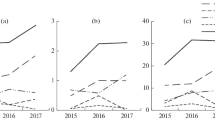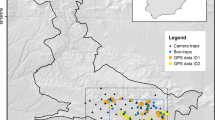Summary
We have devised a census formula of curvilinear regression suitable for capture-recapture data of recapture-addicted populations of the Japanese field vole (Microtus montebelli) obtained under a grid-plan with single-catch traps in order to estimate the whole population. The equation is founded on the assumption that the trappable population on the initial day is increased in way of an exponential curve until it reaches to the whole during one trapping period. The effect of trap-preoccupation by marked and multiple collisions is considered in the formula. As a result of its application to field data of the vole, it has turned out that the equation is required for the data gained under the trapping plan with trap spacing 10m, but not for those under the plan with spacing 5m, to estimate the whole. A convenient method of analysis of the formula is offered here, but we have been yet unable to introduce assymptotic variance of estimates.
Similar content being viewed by others
References
Leslie, P. H. andD. H. S. Davis (1939) An attempt to determine the absolute number of rats on a given area.J. Anim. Ecol. 8: 94–113.
Leslie, P. H., D. Chitty andH. Chitty (1953) The estimation of population parameters from data by means of the capture-recapture method. III. An example of the practical application of the method.Biometrika 40: 137–169.
Sheppe, W. (1966) Exploration by the deer mouse,Peromyscus leucopus.Amer. Midl. Nat. 76: 257–276
Tanaka, R. andS. Teramura (1953) A population of the Japanese field vole infested with tsutsugamushi disease.J. Mamm. 34: 345–352
Tanaka, R. (1956) On differential response to live traps of marked and unmarked small mammals.Annot. Zool. Jap. 29: 44–51.
Tanaka, R., H. Sugiyama andS. Teramura (1958) A clumped distribution of tromniculid mites viewed from the true home range of host voles.Jap. J. Sanit. Zool. 9: 28–32.
Tanaka, R. (1960) Evidence against reliability of the trap-night index as a relative measure of population in small mammals.Jap. J. Ecol. 10: 102–106.
Tanaka, R. (1963a) On the problem of trap-response types of small mammal populations.Res. Popul. Ecol. 5: 139–146.
Tanaka, R. (1963b) Examination of the routine census equation by considering multiple collisions with a single-catch trap in small mammals.Jap. J. Ecol. 13: 16–21.
Tanaka, R. (1966) A possible discrepancy between the exposed and the whole population depending upon range-size and trap-spacing in vole populations.Res. Popul. Ecol. 8: 93–101.
Tanaka, R. (1967)Ecology of rats, mice and voles. Tokyo (in Japanese).
Zippin, C. (1956) An evaluation of the removal method of estimating animal populations.Biometrics 12: 163–189.
Author information
Authors and Affiliations
Additional information
Contributions from JIBP-PT No. 19, carried out by the grant from the expenditure of Education Department to the specific study on “Dynamics of Biosphere”.
Rights and permissions
About this article
Cite this article
Tanaka, R., Kanamori, M. New regression formula to estimate the whole population for recapture-addicted small mammals. Res Popul Ecol 9, 83–94 (1967). https://doi.org/10.1007/BF02514916
Issue Date:
DOI: https://doi.org/10.1007/BF02514916




